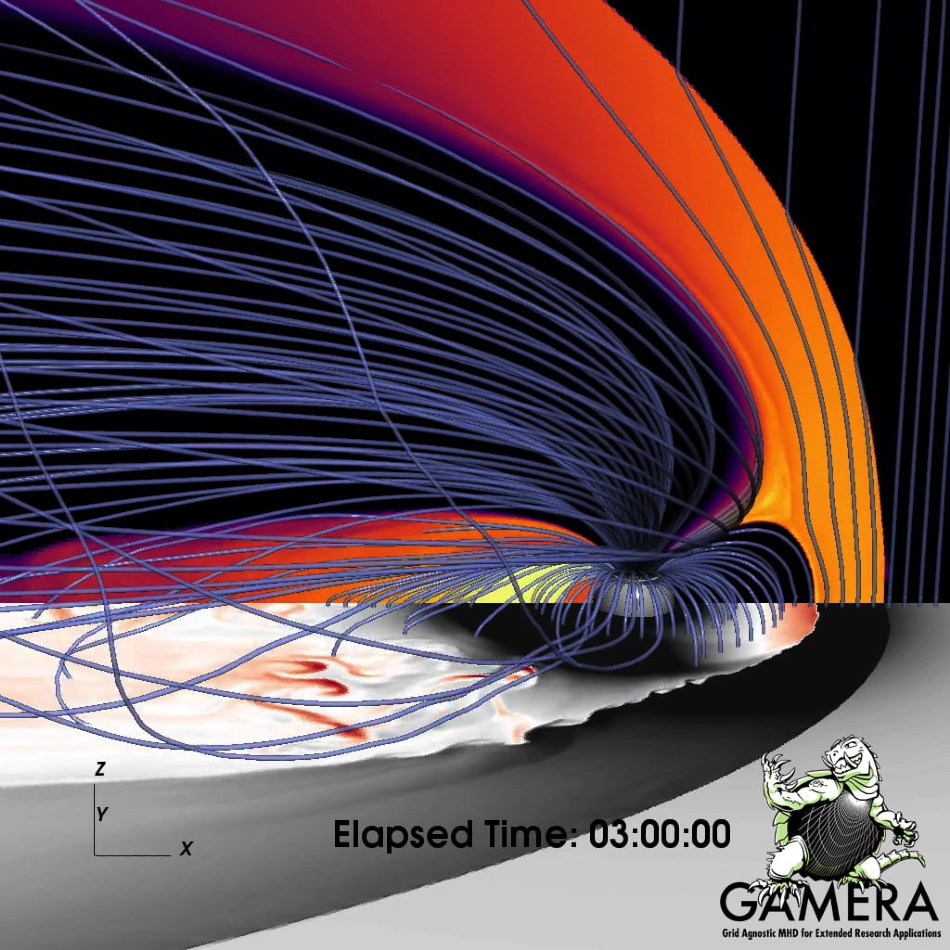Dec 23 2019
The solar wind striking the dayside magnetosphere of the Earth leads to turbulence, just like how air does over a wing. Now, new techniques have been developed by Rice University physicists to characterize how that turbulence impacts space weather on the nightside of the Earth.
 An image from a magnetohydrodynamic simulation by the Gamera project at the Johns Hopkins Applied Physics Laboratory shows bursty flows (in red and brown) in the plasma sheet. Rice University space plasma physicists developed algorithms to measure the buoyancy waves that appear in thin filaments of magnetic flux on Earth’s nightside. Image Credit: K. Sorathia/JHUAPL.
An image from a magnetohydrodynamic simulation by the Gamera project at the Johns Hopkins Applied Physics Laboratory shows bursty flows (in red and brown) in the plasma sheet. Rice University space plasma physicists developed algorithms to measure the buoyancy waves that appear in thin filaments of magnetic flux on Earth’s nightside. Image Credit: K. Sorathia/JHUAPL.
It is mostly noisy up there. After streaming around the planet, the solar wind travels off into the night, but nearer to the planet, plasma parcels get trapped in the turbulence and fall back toward the Earth. This turbulence leads to large ripples in the plasma.
Using many computational tools and spacecraft designed over the last 10 years, a Rice University research team headed by Frank Toffoletto, a space plasma physicist, can currently evaluate the ripples—referred to as buoyancy waves—induced by the turbulence.
These buoyancy waves, also known as oscillations, have been noticed in the thin magnetic flux layer along the bottom of the plasma sheet. This plasma sheet tails away from the nightside of the planet. The theory developed at Rice University is the first to measure the motion of these buoyancy waves. It adds one more element to the Convection Model developed at Rice University.
The Convection Model is an established algorithm that took many years to develop. It helps researchers to determine the way the middle and inner magnetosphere will respond to events like solar storms threatening power grids, communications, and satellites on Earth.
Toffoletto, emeritus professor Richard Wolf, and Aaron Schutza, a former graduate student, have published a new article in JGR Space Physics. The article begins by elucidating the bubbles—“bursty bulk flows” predicted in 1990 by Wolf and Rice alumnus Duane Pontius—that sink back toward the Earth via the plasma tail.
From the functional standpoint, these bubbles are the reverse of buoyant air bubbles bobbing up and down in the air as a result of gravity; however, the plasma bubbles instead react with the magnetic fields.
Most of the momentum of the plasma bubbles is lost by the time they make contact with the filament-like, theoretical boundary existing between the protective plasmasphere and the inner plasma sheet.
That triggers the braking boundary into a mild oscillation, lasting only minutes and then stabilizing again. According to Toffoletto, the motion can be compared to a plucked guitar string that rapidly returns to the equilibrium state.
The fancy name for this is the eigenmode. We’re trying to figure out the low-frequency eigenmodes of the magnetosphere. They haven’t been studied very much, though they appear to be associated with dynamic disruptions to the magnetosphere.
Frank Toffoletto, Space Plasma Physicist, Rice University
In recent years, the research team at Rice University has identified via simulations that the magnetosphere does not invariably react in a linear manner to the uniform driving force of the solar wind, stated Toffoletto.
“You get all kinds of wave modes in the system,” he added, describing that one such mode is the bursty bulk flows. “Every time one of these things come flying in, when they hit the inner region, they basically reach their equilibrium point and oscillate with a certain frequency. Finding that frequency is what this paper is all about.”
The periods of these buoyant waves take a few minutes and the amplitudes are usually larger than the Earth, as quantified by the THEMIS spacecraft.
Understanding the natural frequency of the system and how it behaves can tell us a lot about the physical properties of plasma on the nightside, its transport and how it might be related to the aurora. A lot of these phenomena show up in the ionosphere as auroral structures, and we don’t understand where these structures come from.
Frank Toffoletto, Space Plasma Physicist, Rice University
According to Toffoletto, the models indicate that buoyant waves are likely to contribute to the formation of the ring current containing charged particles. These particles flow not only around Earth but also around magnetospheric substorms, which are collectively linked to the aurora.
Toffoletto stated that about 10 years ago, several magnetosphere simulations “would look very uniform, kind of boring.” The Rice University team has collaborated with the Applied Physics Laboratory to add the Rice Convection Model in a recently designed universal magnetosphere code known as “Gamera,” dubbed after the imaginary Japanese monster.
Now, with such higher-resolution models and much better numerical methods, these structures are starting to show up in the simulations. This paper is one little piece of the puzzle we’re putting together of how the system behaves. All this plays a big role in understanding how space weather works and how that in turn impacts technology, satellites and ground-based systems.
Frank Toffoletto, Space Plasma Physicist, Rice University
The Convection Model developed by Rice University itself was recently revamped in a paper headed by new Rice alumnus Jian Yang. Yang is currently an associate professor of Earth and space sciences at the Southern University of Science and Technology, Shenzhen, China.
A NASA Heliophysics Supporting Research grant supported the latest study.
Buoyancy wave demonstration
A simulation by Rice University space plasma physicist Frank Toffoletto shows buoyancy wave oscillations in a magnetic field, due to bursty bulk flows drawn toward Earth on the nightside. Video Credit: Frank Toffoletto.